Data Cleansing vs Data Enrichment
Data plays a critical role in driving decisions, but its quality determines its value. Data cleansing ensures your data is accurate by removing errors and inconsistencies. On the other hand, data enrichment enhances this cleaned data by adding valuable context and insights. Together, these processes transform raw information into a powerful asset. Poor data quality costs businesses billions annually, with U.S. enterprises losing $12.9 million on average each year. The importance of data cleaning lies in its ability to eliminate inaccuracies, while enrichment amplifies the data’s potential for actionable insights.
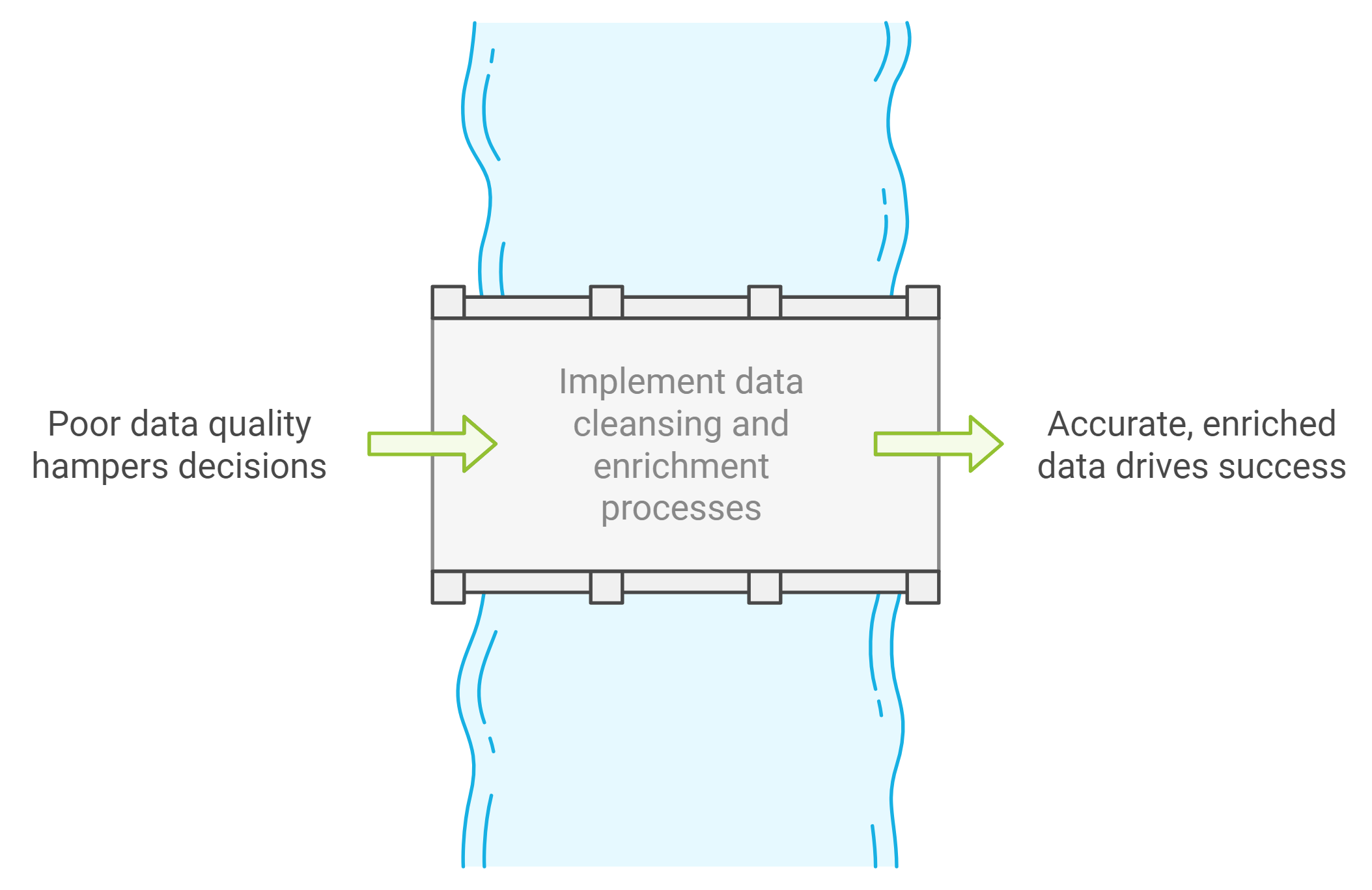
Key Takeaways
Data cleansing is essential for ensuring the accuracy and reliability of your datasets by removing errors and inconsistencies.
Data enrichment enhances existing data by adding valuable context, such as demographic details or purchasing behaviors, making it more actionable.
Both processes are crucial for improving decision-making; clean data leads to informed choices, while enriched data uncovers deeper insights.
Investing in data cleansing and enrichment tools can streamline your data management processes, saving time and enhancing data quality.
Combining data cleansing and enrichment not only improves operational efficiency but also provides a competitive advantage in understanding your market and audience.
Accurate and enriched data fosters better customer relationships by enabling personalized communication and tailored marketing strategies.
What is Data Cleansing?
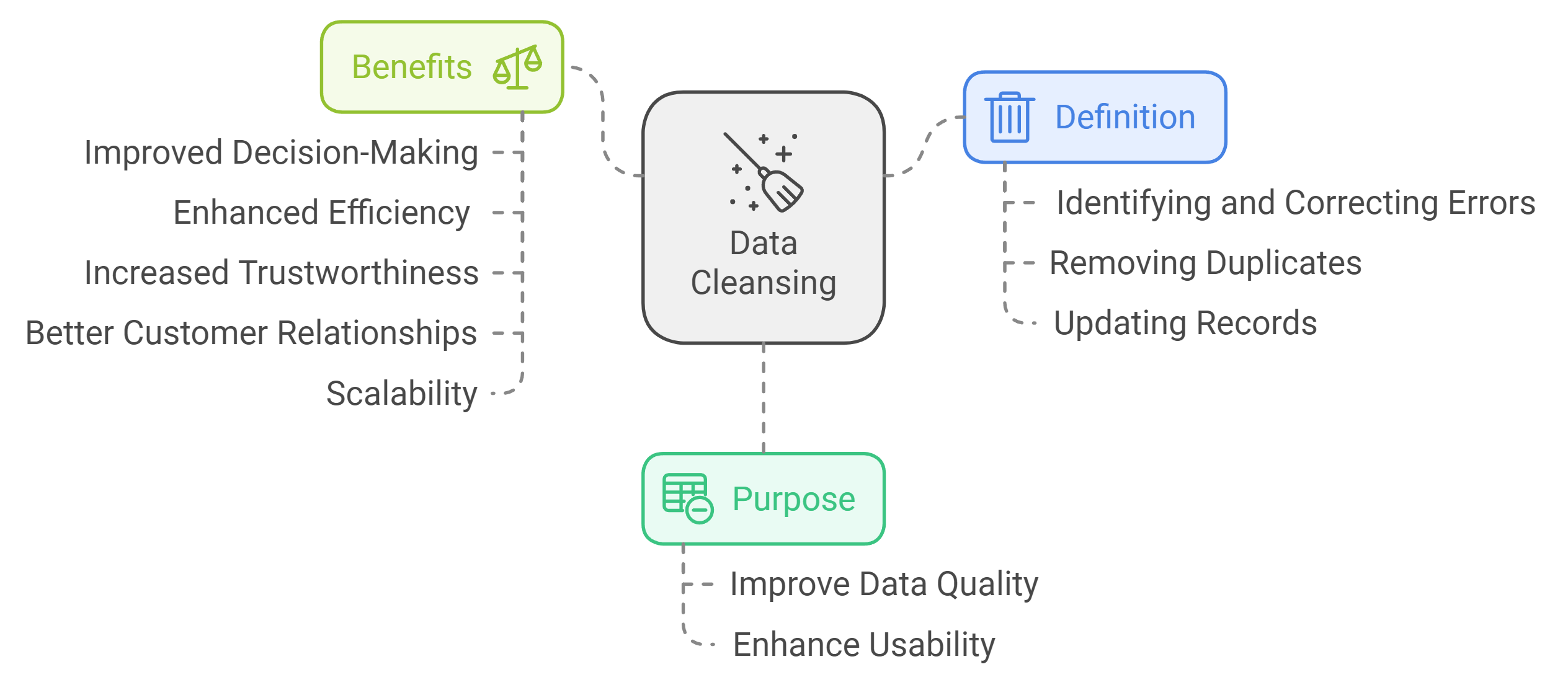
Definition of Data Cleansing
Data cleansing refers to the process of identifying and correcting errors, inconsistencies, and inaccuracies within a dataset. It ensures that your data is accurate, reliable, and ready for analysis. This process involves removing duplicate entries, fixing incorrect information, and updating outdated records. By addressing these issues, data cleansing transforms raw, messy data into a structured and trustworthy resource.
According to experts, data cleansing focuses on maintaining the integrity of existing data by eliminating mistakes and ensuring consistency. This step is essential for making data suitable for further use.
Purpose of Data Cleansing
The primary purpose of data cleansing is to improve the quality of your data. Clean data allows you to make informed decisions and derive meaningful insights. When your data is free from errors, it becomes a dependable foundation for analytics, reporting, and strategic planning. For instance, if you analyze customer data, cleansing ensures that names, addresses, and contact details are accurate, preventing miscommunication or wasted resources.
Another goal of data cleansing is to enhance the usability of your data. Raw datasets often contain irrelevant or redundant information, which can hinder analysis. By removing unnecessary elements, you streamline your data, making it easier to work with and interpret.
Benefits of Data Cleansing
Data cleansing offers several advantages that directly impact your business operations:
Improved Decision-Making: Clean data ensures that your analysis is based on accurate information, leading to better decisions.
Enhanced Efficiency: By eliminating duplicates and irrelevant data, you save time and resources during data processing.
Increased Trustworthiness: Reliable data builds confidence among stakeholders, whether they are team members or external partners.
Better Customer Relationships: Accurate customer data helps you personalize communication and improve customer satisfaction.
Scalability: Clean data is easier to scale, allowing you to handle larger datasets without compromising quality.
"With data cleansing, you will be able to make the most of each data point, no matter the volume of information." This highlights how cleansing unlocks the potential of your data, making it a valuable asset for your organization.
In today’s data-driven world, data cleansing is not just a technical task—it is a strategic necessity. By ensuring the accuracy and reliability of your data, you set the stage for meaningful insights and successful outcomes.
What is Data Enrichment?
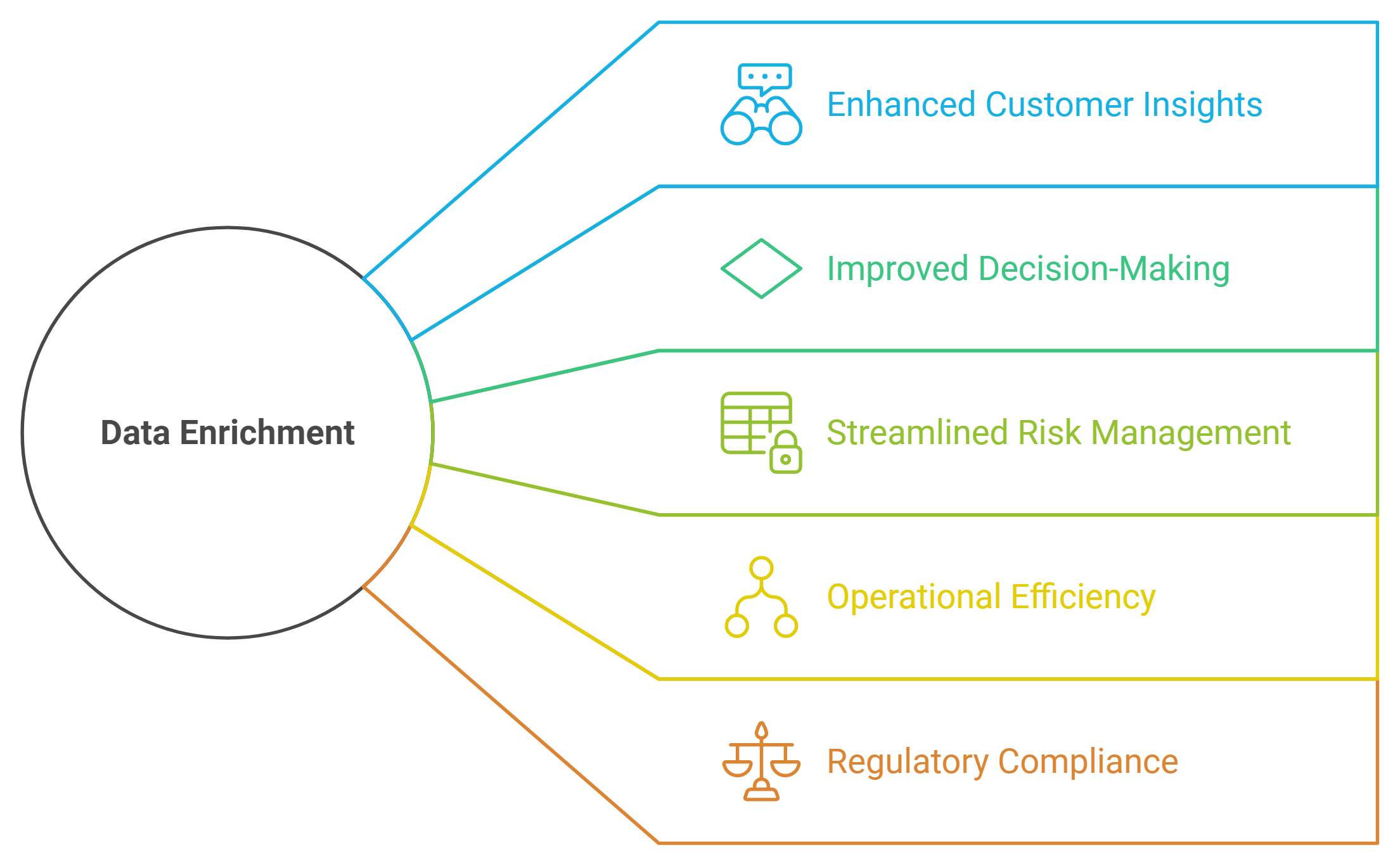
Definition of Data Enrichment
Data enrichment refers to the process of enhancing your existing datasets by adding new, relevant information. This process improves the quality and depth of your data, making it more valuable for analysis and decision-making. For example, you can enrich customer data by appending demographic details, social media profiles, or purchasing behaviors. By integrating additional insights, data enrichment transforms basic information into a comprehensive resource.
"Data enrichment enhances raw data by appending external information, creating a richer dataset for better insights." This approach ensures that your data evolves into a more actionable and meaningful asset.
Purpose of Data Enrichment
The primary purpose of data enrichment is to provide a more complete and accurate picture of your data. It helps you uncover hidden patterns, identify opportunities, and make informed decisions. Enrichment bridges the gaps in your datasets by incorporating external data sources, such as firmographics, technographics, or behavioral intent data. This process allows you to gain deeper insights into your audience, market trends, or operational performance.
For instance, if you manage a marketing campaign, enriched data enables you to segment your audience more effectively. You can tailor your messaging based on customer preferences, location, or past interactions. This level of precision improves engagement and drives better results.
Benefits of Data Enrichment
Data enrichment offers numerous advantages that elevate the value of your data and support your business goals:
Enhanced Customer Insights: Gain a deeper understanding of your customers by integrating additional details like demographics or purchasing habits.
Improved Decision-Making: Access to enriched data ensures that your strategies are based on comprehensive and accurate information.
Streamlined Risk Management: Identify potential risks or anomalies in your data, enabling proactive measures to mitigate issues.
Operational Efficiency: Enriched data reduces redundancies and improves workflows, saving time and resources.
Regulatory Compliance: Ensure your data meets industry standards by appending necessary compliance-related information.
"Data enrichment refines and enhances datasets, enabling businesses to derive profound insights and make smarter decisions." This highlights how enrichment transforms data into a strategic tool for success.
By enriching your data, you unlock its full potential and gain a competitive edge. The process not only adds value but also ensures that your data remains relevant and actionable in a rapidly changing environment.
Key Differences Between Data Cleansing and Data Enrichment
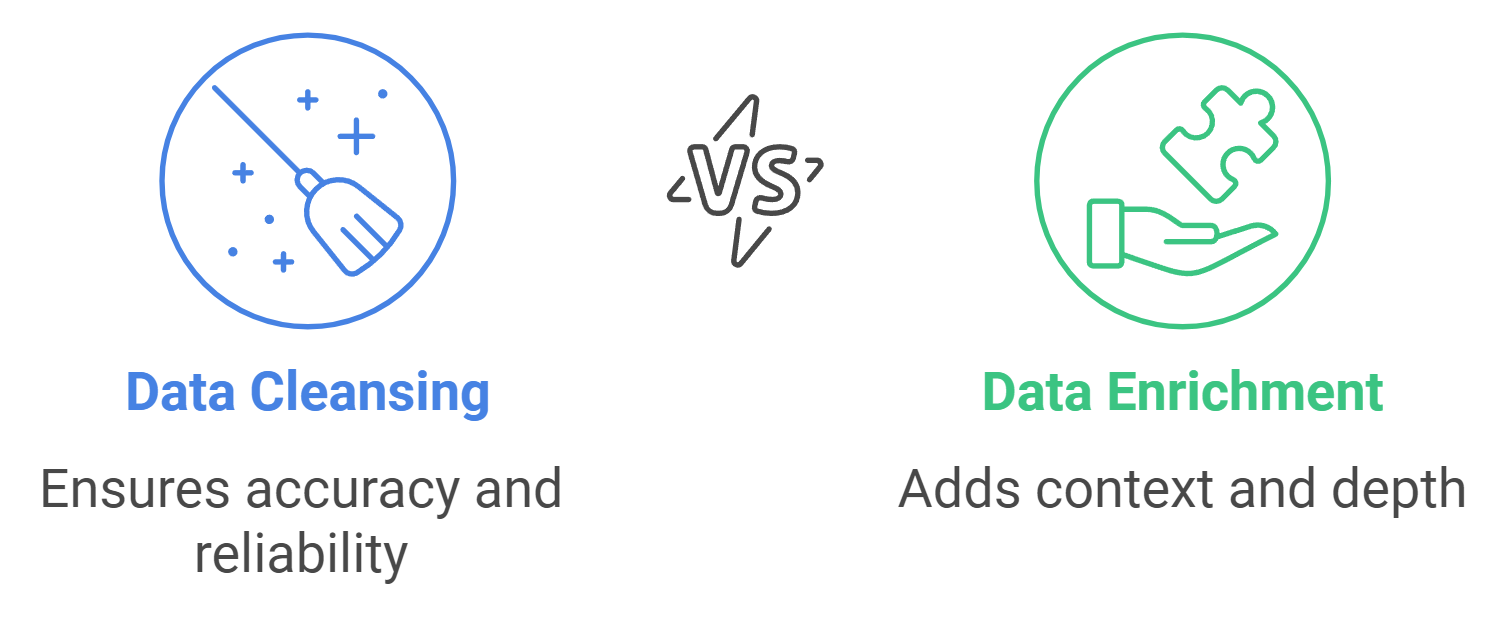
Focus and Objectives
Data cleansing and data enrichment serve distinct purposes, each addressing different aspects of data management. Data cleansing focuses on improving the accuracy and reliability of your existing data. It identifies and removes errors, outdated information, and duplicates. This process ensures that your data is free from inconsistencies, making it suitable for analysis and decision-making.
In contrast, data enrichment enhances your data by adding new, relevant information. Its primary goal is to provide additional context and depth to your datasets. For example, enriching customer data with demographic details or purchasing behaviors allows you to gain a more comprehensive understanding of your audience. While cleansing ensures your data is correct, enrichment transforms it into a more valuable resource.
"Data cleansing corrects and purifies the data, while enrichment enhances and expands it." This distinction highlights how each process contributes uniquely to data quality.
Processes Involved
The processes involved in data cleansing and data enrichment differ significantly. Data cleansing typically includes tasks like removing duplicate entries, correcting errors, and updating outdated records. It also involves cross-checking and validating existing data to ensure consistency and accuracy. These steps focus solely on refining the data you already have.
Data enrichment, on the other hand, involves integrating external data sources to append new information to your datasets. This process might include adding firmographic data, social media profiles, or behavioral insights. Unlike cleansing, enrichment does not modify or correct existing data. Instead, it supplements your data with additional layers of information, making it richer and more actionable.
"A good data cleansing process involves cross-checking and validating already existing data, whereas data enrichment focuses only on the data added." This comparison underscores the complementary nature of these processes.
Outcomes
The outcomes of data cleansing and data enrichment reflect their unique roles in data management. Data cleansing delivers clean, accurate, and reliable datasets. This ensures that your decisions are based on trustworthy information. Clean data also improves operational efficiency by eliminating redundancies and errors.
Data enrichment, however, results in datasets that are more insightful and comprehensive. By adding valuable context, enrichment enables you to uncover hidden patterns, identify opportunities, and make well-informed decisions. For instance, enriched data can help you segment your audience more effectively, leading to better-targeted marketing campaigns.
"Cleaning ensures accuracy, while enrichment provides added depth, leading to more powerful insights and well-informed decisions." This outcome demonstrates how both processes work together to maximize the value of your data.
By understanding these key differences, you can leverage both data cleansing and data enrichment to achieve high-quality, actionable data. Each process plays a vital role in ensuring that your data not only meets quality standards but also delivers meaningful insights.
How Data Cleansing and Data Enrichment Complement Each Other
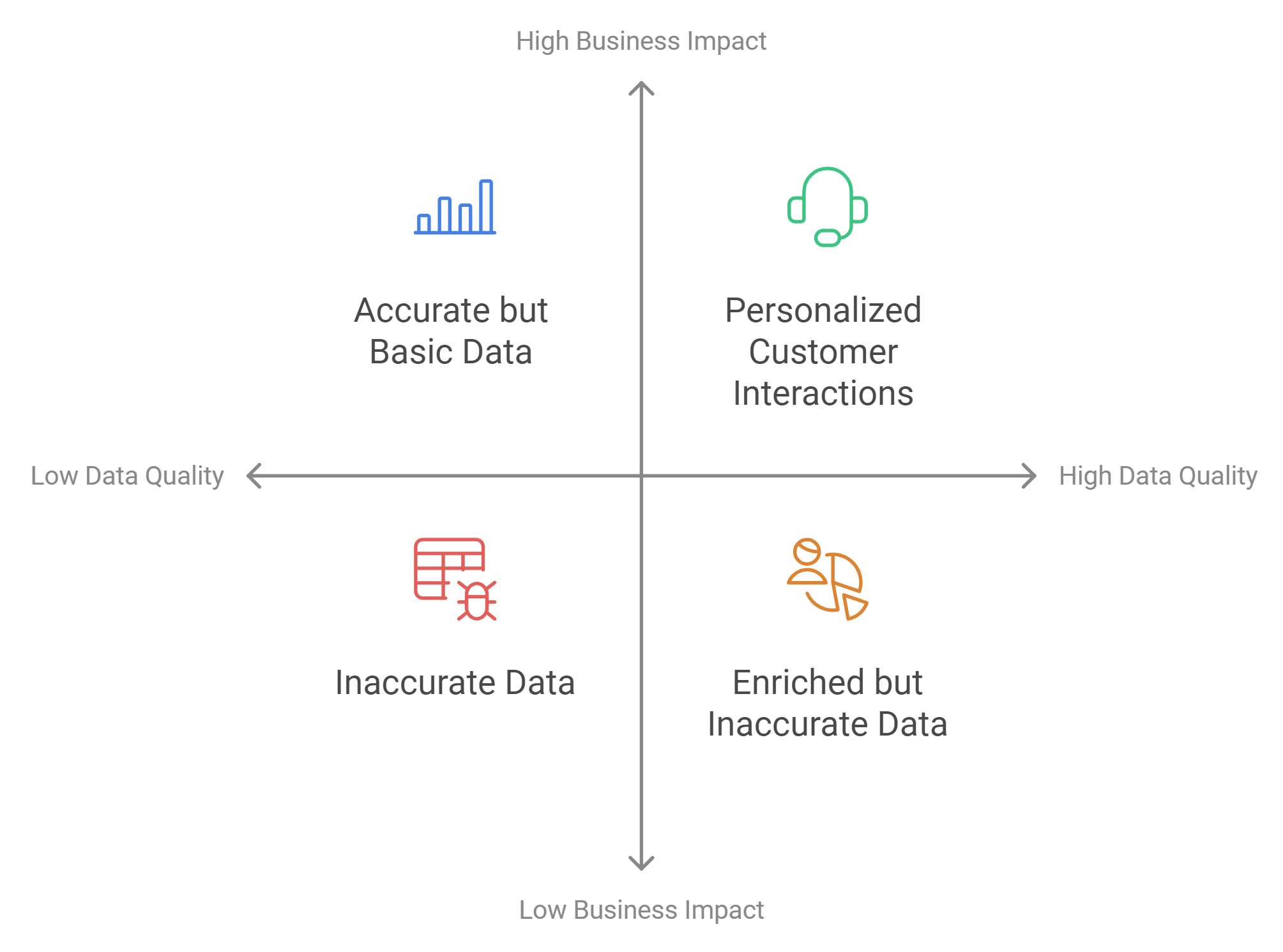
The Relationship Between Cleansing and Enrichment
Data cleansing and data enrichment work hand in hand to maximize the value of your data. Cleansing ensures that your data is accurate and free from errors, creating a solid foundation for further enhancement. Enrichment builds on this foundation by adding new layers of information, transforming clean data into a more insightful and actionable resource.
For example, imagine you manage a customer database. Data cleansing removes duplicate entries, corrects misspelled names, and updates outdated contact details. Once the data is clean, enrichment allows you to append additional information, such as customer preferences or purchase history. Together, these processes provide a complete and reliable dataset that supports better decision-making.
"Accurate data helps customer service agents respond faster and with more personalized support. Enriched data allows agents to access a complete customer history, making interactions more seamless and effective." This highlights how cleansing and enrichment complement each other to improve customer experiences.
By combining these processes, you ensure that your data is not only error-free but also enriched with valuable insights. This synergy enhances the usability and relevance of your data, enabling you to achieve your business goals more effectively.
Combined Benefits for Businesses
When you integrate data cleansing and data enrichment into your data management strategy, your business gains several advantages:
Improved Customer Experiences: Clean and enriched data enables you to understand your customers better. You can personalize interactions, address their needs more effectively, and build stronger relationships. For instance, enriched customer data provides a complete history, allowing your team to offer tailored solutions quickly.
Enhanced Decision-Making: Reliable and comprehensive data ensures that your decisions are based on accurate and detailed information. This reduces the risk of errors and helps you identify opportunities with greater precision.
Operational Efficiency: Clean data eliminates redundancies, while enriched data streamlines workflows by providing all necessary information in one place. This saves time and resources, allowing your team to focus on strategic tasks.
Competitive Advantage: Businesses that leverage both cleansing and enrichment gain a deeper understanding of their market and audience. This insight helps you stay ahead of competitors by making informed and proactive decisions.
"Cleaning ensures accuracy, while enrichment provides added depth, leading to more powerful insights and well-informed decisions." This demonstrates how the combination of these processes creates a robust data strategy.
By leveraging the combined power of data cleansing and data enrichment, you unlock the full potential of your data. These processes not only improve the quality of your data but also enhance its value, helping your business thrive in a data-driven world.
Real-World Applications and Tools
Examples of Data Cleansing in Action
Data cleansing plays a vital role in various industries by ensuring the accuracy and reliability of datasets. For instance, in the healthcare sector, hospitals use data cleansing to maintain accurate patient records. This process removes duplicate entries, corrects errors in medical histories, and updates outdated contact information. Clean data ensures that healthcare providers deliver precise diagnoses and treatments.
In the retail industry, businesses rely on data cleansing to optimize their customer databases. By eliminating duplicate customer profiles and correcting misspelled names or addresses, companies can streamline their marketing efforts. Accurate data allows retailers to send personalized offers to the right customers, improving engagement and boosting sales.
"Data cleansing ensures that your analysis is based on accurate and reliable information, leading to better decision-making and operational efficiency."
Examples of Data Enrichment in Action
Data enrichment enhances datasets by adding valuable context and insights, making it indispensable across industries. In marketing, companies enrich customer data by appending demographic details, purchasing behaviors, or social media activity. This enriched data enables marketers to create targeted campaigns that resonate with specific audience segments.
In the financial sector, banks use data enrichment to assess creditworthiness. By integrating external data sources, such as credit scores or employment history, financial institutions gain a comprehensive view of their clients. This enriched data helps them make informed lending decisions and manage risks effectively.
Another example comes from e-commerce platforms. These businesses enrich product data by adding customer reviews, ratings, and detailed descriptions. This additional information improves the shopping experience, helping customers make well-informed purchasing decisions.
"Data enrichment transforms basic datasets into comprehensive resources, enabling businesses to uncover hidden patterns and make smarter decisions."
Tools for Data Cleansing and Enrichment
Investing in the right tools can significantly enhance your data management processes. Data cleansing tools automate tasks like deduplication, error correction, and data validation. These tools often include features such as automated data profiling, standardization, and parsing. By using these tools, you can save time and ensure that your data remains accurate and consistent.
For data enrichment, data enrichment tools offer functionalities to append new information to your datasets. Look for tools that support integration with external data sources and provide methods for enriching data efficiently. Features like ease of use and data quality assurance are essential for maximizing the value of these tools.
Some software solutions combine both cleansing and enrichment capabilities. Data quality software automates the entire process, from cleansing to enrichment, ensuring that your data meets high standards. These tools streamline workflows, reduce manual effort, and improve the overall quality of your datasets.
"By leveraging advanced tools for data cleansing and enrichment, you can transform raw data into a powerful asset that drives business success."
Data cleansing and data enrichment serve distinct yet complementary roles in data management. Cleansing ensures your data remains accurate and reliable, while enrichment adds depth and context to unlock new insights. Together, these processes create a foundation for actionable and valuable data.
Balancing both processes allows you to make informed decisions and stay competitive in a data-driven world. Investing in tools and strategies that support cleansing and enrichment enhances data quality and usability. By leveraging both, you transform raw information into a powerful asset for your business.
See Also
How Data Governance Ensures High Standards for Data Quality
Comparing Data Leadership and Effective Data Management
Boosting Data Teams Through Essential Business Literacy Skills
